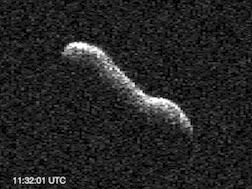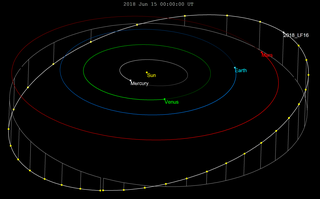Related Research Articles
The Torino scale is a method for categorizing the impact hazard associated with near-Earth objects (NEOs) such as asteroids and comets. It is intended as a communication tool for astronomers and the public to assess the seriousness of collision predictions, by combining probability statistics and known kinetic damage potentials into a single threat value. The Palermo Technical Impact Hazard Scale is a similar, but more complex scale. Near-Earth objects with a Torino scale of 1 are discovered several times a year, and may last a few weeks until they have a longer observation arc that eliminates any possibility of a collision. The highest rating ever assigned on the Torino Scale was given to the asteroid 99942 Apophis, which had a rating of 4 for four days in late 2004.
(292220) 2006 SU49, provisional designation 2006 SU49, is a sub-kilometer asteroid, classified as near-Earth object and potentially hazardous asteroid of the Apollo group that had a small chance of impacting Earth in 2029.
(144898) 2004 VD17, provisional designation 2004 VD17, is a sub-kilometer asteroid, classified as near-Earth object of the Apollo group once thought to have a low probability of impacting Earth on 4 May 2102. It reached a Torino Scale rating of 2 and a Palermo Technical Impact Hazard Scale rating of -0.25. With an observation arc of 17 years it is known that closest Earth approach will occur two days earlier on 2 May 2102 at a distance of about 5.5 million km.
(481482) 2007 CA19 is a sub-kilometer asteroid, classified as near-Earth object and potentially hazardous asteroid of the Apollo group. It led the impact hazard list, with a Torino Scale impact risk value of 1, for one week, ending on February 19, 2007. Before and after 2007 CA19, 99942 Apophis was the object with the highest Palermo Scale rating. With an observation arc of 4.8 days, it had a Palermo Scale of −0.88.

2007 VK184 is a sub-kilometer asteroid, classified as a near-Earth object of the Apollo group, and estimated to be approximately 130 meters (430 ft) in diameter. It was listed on the Sentry Risk Table with a Torino Scale rating of 1 for a potential impactor in June 2048. It was removed from the Sentry Risk Table on 28 March 2014.
(332446) 2008 AF4 is a sub-kilometer asteroid, classified as near-Earth object and potentially hazardous asteroid of the Apollo group, which was listed on the Sentry Risk Table in January 2008 with a Torino Scale rating of 1. The asteroid showed a 1 in 71,000 chance of impact on 9 January 2089. It was briefly downgraded to Torino Scale 0 in February 2008, but still showed a cumulative 1 in 53,000 chance of an impact. In March it was back at Torino Scale 1 with a 1 in 28,000 chance of impact on 9 January 2089. By mid April 2008, it was back to Torino Scale 0. It was removed from the Sentry Risk Table on 19 December 2009.

(367789) 2011 AG5, provisional designation 2011 AG5, is a sub-kilometer asteroid, classified as near-Earth object and potentially hazardous asteroid of the Apollo group. It has a diameter of about 140 meters (460 ft). It was removed from the Sentry Risk Table on 21 December 2012 and as such it now has a rating of 0 on the Torino Scale. It was recovered in December 2022 extending the observation arc from 4.8 years to 14 years. As of 2023, the distance between the orbits of Earth and 2011 AG5 is 0.0004 AU (60,000 km; 0.16 LD)
(471240) 2011 BT15, provisional designation 2011 BT15, is a stony, sub-kilometer sized asteroid and fast rotator, classified as a near-Earth object and potentially hazardous asteroid of the Apollo group. It had been one of the objects with the highest impact threat on the Palermo Technical Impact Hazard Scale.
2012 KP24 (also written 2012 KP24) is a Chelyabinsk-sized near-Earth asteroid with an observation arc of only 5 days and has a modestly determined orbit for an object of its size. Around 31 May 2023 ±3 days it will pass between 0.19–24 lunar distances (73,000–9,200,000 km) from Earth. Nominally the asteroid is expected to pass 0.026 AU (3,900,000 km; 10 LD) from Earth and brighten to around apparent magnitude 21.6.
(454101) 2013 BP73, provisional designation 2013 BP73, is a sub-kilometer asteroid, classified as a near-Earth object and potentially hazardous asteroid of the Apollo group, approximately 310 meters (1,020 ft) in diameter.
(163132) 2002 CU11, provisional designation 2002 CU11, is a bright, sub-kilometer asteroid, classified as near-Earth object and potentially hazardous asteroid of the Apollo group. Based on absolute magnitude, it is the second largest asteroid known to have passed closer than the Moon.
2013 TV135 is an Apollo near-Earth asteroid estimated to have a diameter of 450 meters (1,480 ft). On 16 September 2013, it passed about 0.0448 AU (6,700,000 km; 4,160,000 mi) from Earth. On 20 September 2013, it came to perihelion (closest approach to the Sun). The asteroid was discovered on 12 October 2013 by Ukrainian amateur astronomer Gennadiy Borisov with a custom 0.2-meter (7.9 in) telescope using images dating back to 8 October 2013. It was rated level 1 on the Torino Scale from 16 October 2013 until JPL solution 26 on 3 November 2013. It reached a Palermo Technical Impact Hazard Scale rating of -0.73. It was removed from the JPL Sentry Risk Table on 8 November 2013 using JPL solution 32 with an observation arc of 27 days.
2007 VE191 is a sub-kilometer asteroid, classified as near-Earth asteroid of the Apollo group that was listed on the Sentry Risk Table.
2014 XL7 is a near-Earth object and Apollo asteroid, approximately 230 meters (750 feet) in diameter. It was the most dangerous potentially hazardous asteroid on Sentry Risk Table upon its discovery by the Mount Lemmon Survey in December 2014. At the time, the asteroid had a cumulative 1 in 83000 chance of impacting Earth on 4–5 June between the years 2048 and 2084. After the object's observation arc had been extended to 35 days, it was removed from the Sentry Risk Table on 15 January 2015. Since then the asteroid's orbit has been secured. Although it has an Earth minimum orbit intersection distance of less than one lunar distance, there are no projected close encounters with Earth in the foreseeable future, with its closest passage to occur in May 2046, still millions of kilometers away.
(585310) 2017 YZ1, provisional designation: 2017 YZ1, is a sub-kilometer asteroid on an eccentric orbit, classified as near-Earth object and potentially hazardous asteroid of the Apollo group, approximately 250 meters (800 feet) in diameter. It was first observed on 20 December 2017, by astronomers with the Mount Lemmon Survey at Mount Lemmon Observatory near Tucson, Arizona, in the United States. On 29 January 2018, it passed Earth at 125 lunar distances.

2017 XO2, also written 2017 XO2, is a sub-kilometer asteroid and near-Earth object of the Apollo group approximately 110 meters (360 feet) in diameter. The asteroid was discovered by Pan-STARRS in December 2017, after it already had approached Earth at 0.051 AU (7,600,000 km) or 20 lunar distances (LD) on 6 November 2017. On 26 April 2057, it will pass Earth at a similar distance of 21 LD again.

2018 LF16 is a small Mars crossing asteroid roughly 213 m (699 ft) in diameter. It was first observed by astronomers with the Pan-STARRS survey at Haleakala Observatory on 14 June 2018. It was removed from the Sentry Risk Table on 29 July 2021. With an observation arc of 15 years the orbit is very well known and it does not make any notable approaches to Earth.
2022 AE1 is a Tunguska event-sized asteroid, classified as a near-Earth object of the Apollo group, approximately 70 meters (230 feet) in diameter. It was discovered by the Mount Lemmon Survey on 6 January 2022, when it was 0.09 AU (13 million km) from Earth. On 9 January 2022 with an observation arc of 3 days, it was rated with a Torino scale of 1 for a virtual impactor on 4 July 2023 16:28 UTC. Nominal approach is expected to occur 1 July 2023 01:13 ± 1 day. With a Palermo scale rating of as high as –0.66 at the European Space Agency on 11 January 2022, the odds of impact peaked at about 4.6 times less than the background hazard level. NEODyS was the first risk-page to drop to Torino scale 0 on 12 January 2022 followed by ESA on 13 January 2022, but by January 14 both returned to Torino scale 1. On 14 January 2022 the waxing gibbous moon was as little as 3 degrees from the asteroid delaying observations of the asteroid from January 12–19. On 20 January 2022 with a 16-day observation arc, using JPL #11 the Sentry Risk Table dropped the asteroid to Torino scale 0 and then later that day JPL #12 resulted in it being removed from the risk table.
2022 QX4 is a Tunguska event-sized asteroid, classified as a near-Earth object of the Aten group, approximately 40 meters (130 feet) in diameter. It was discovered by ATLAS on 24 August 2022, when it was 0.03 AU (4.5 million km) from Earth. On 4 September 2022 with an observation arc of 8 days, it was listed with a 1-in-109 chance of impacting Earth with a Torino scale of 1 for a virtual impactor on 4 September 2068 00:52 UTC. Five precovery images from August 2013 were published on 11 September 2022 extending the observation arc to 9 years and 2022 QX4 was removed from the Sentry Risk Table. The nominal approach is expected to occur 26 August 2068.
2023 GQ2 is an asteroid roughly 400 meters in diameter, classified as a near-Earth object and potentially hazardous object of the Apollo group. It was first discovered on 12 April 2023, when it was 1.3 AU (190 million km) from Earth, with the Bok Telescope at Kitt Peak National Observatory. On 19 April 2023, with an observation arc of 6.7 days, it was rated 1 on the Torino scale for a virtual impactor on 16 November 2028 at 00:58 UTC. When it had a Palermo scale rating of –0.70, the odds of impact were about 5 times less than the background hazard level and this gave the asteroid one of the highest Palermo scale ratings ever issued. On 20 April 2023 precovery images from May 2019 were announced extending the observation arc to 3.9 years, and the 2028 virtual impactor was removed from the Sentry Risk Table. It is now known the nominal approach will safely occur about 13 hours after the impact scenario on 16 November 2028 13:36 ± 40 minutes.
References
- 1 2 "MPEC 2003-Q46 : 2003 QQ47". IAU Minor Planet Center. 27 August 2003. Retrieved 12 February 2014. (K03Q47Q)
- 1 2 3 4 "JPL Close-Approach Data: 143649 (2003 QQ47)" (2006-04-27 last obs). Retrieved 7 April 2016.
- 1 2 3 4 5 6 7 Johnston, Wm. Robert (25 September 2021). "Asteroids with Satellites Database – (143649) 2003 QQ47". Johnston's Archive. Retrieved 1 October 2021.
- 1 2 3 "Asteroid 2003 QQ47's Potential Earth Impact in 2014 Ruled Out". NASA/JPL Near-Earth Object Program Office. 3 September 2003. Archived from the original on 6 September 2003. Retrieved 6 November 2011.
- ↑ "Earth Impact Risk Summary: 2003 QQ47 (Aug 31 arc=7 days)" (2003-09-01 (computed on 31 August 2003)). Wayback Machine: JPL. Archived from the original on 1 September 2003. Retrieved 3 February 2013. (5.7e-07 = 1 in 1,754,000 chance)
- ↑ "Date/Time Removed". NASA/JPL Near-Earth Object Program Office. Archived from the original on 26 April 2011. Retrieved 6 May 2011.
- ↑ "NEODyS-2 Close Approaches for 2003QQ47". Near Earth Objects – Dynamic Site. Retrieved 6 November 2011.
- ↑ "Asteroid danger in 2014 downplayed". BBC News. 2 September 2003. Retrieved 6 November 2011.